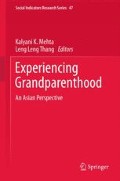Abstract
In this chapter, we analyse the effects that recent demographic, social and economic changes in East and Southeast Asia exert on the relationship between the grandparents and grandchildren. The six regions of Japan, China, Hong Kong, Malaysia, Singapore and Thailand are the main subjects of this analysis. These regions, particularly Japan, have seen a rapidly falling birth rate and a rapidly ageing population over recent years. East and Southeast Asia has been characterised by the ‘flying-geese’ pattern of economic development, in which Japan has been the front-runner, followed by newly industrialising economies and by China and the Association of Southeast Asian Nations (ASEAN). In the demographic area, the birthrate fall and population ageing are also expected to take a flying-geese pattern in which Japan is again the front-runner.
Access this chapter
Tax calculation will be finalised at checkout
Purchases are for personal use only
Notes
- 1.
H. Leibenstein, an economist, cited three utilities of bearing and rearing children: (1) utility as ‘consumer goods’ that give pleasure to parents, (2) utility as ‘production goods’ that provide economic value as labour and (3) utility as ‘old-age security’ in which children are expected to care for parents in their later years. Generally, the first utility declines as per capita GDP increases. The need for the third utility decreases as social security systems develop (Leibenstein 1957). G. S. Becker, also an economist, attributes low fertility to the fact that people try to obtain utilities through ‘better’ children rather than through more children (Becker 1960).
- 2.
The extension of the average life expectancy is owed primarily to a decline in the infant mortality rate. In East Asian countries, however, the elderly mortality rate has also decreased.
- 3.
Per capita GDP exceeded $10,000 in NIEs as of 2006, standing at $18,385 in the Republic of Korea, $16,081 in Taiwan, $31,027 in Singapore and $27,709 in Hong Kong, against $34,238 in Japan.
- 4.
The Social Development Unit (SDU) was founded in 1984 to encourage male and female university graduates to get married. It plans dinners, dance parties and other events for unmarried men and women.
References
Becker, G. S. (1960). An economic analysis of fertility. In A. J. Coale (Ed.), Demographic and economic change in developed countries. Princeton: Princeton University Press.
Cabinet Office, Japan. (2006). White Paper on Birthrate-Declining Society 2005.
Cabinet Office, Japan. (2007a). Awareness survey on elderly livelihood.
Cabinet Office, Japan. (2007b). International comparison survey on elderly people’s livelihood and consciousness.
Chang, K. S. (1999). Compressed modernity and its discontents: South Korean society in transition. Economy and Society, 28(1), 30–55.
Knodel, J., et al. (1995). Living arrangements of elderly in Asia. Journal of Cross-Cultural Gerontology, 10(1&2), 1–6.
Leibenstein, H. (1957). Economic backwardness and economic growth. New York: Wiley.
Ministry of Health, Labor and Welfare (Japan). (2004). National Livelihood Survey (annual), Tokyo.
Ministry of Internal Affairs and Communications. (2007). National Census Report.
National Bureau of Statistics of China. 2000 Census.
Singapore Department of Statistics. (2010). Singapore in figures 2009.
Singapore Department of Statistics. Census of population 2000, Statistical Release 5 Households and Housing.
United Nations Economic and Social Affairs, Population Division. (1995). Demographic Yearbook.
United Nations Economic and Social Affairs, Population Division. (2005). Demographic Yearbook.
United Nations Economic and Social Affairs, Population Division. (2009a). World Marriage Data 2008.
United Nations Economic and Social Affairs, Population Division. (2009b). World Population Prospects: 2008 Revision.
Author information
Authors and Affiliations
Corresponding author
Editor information
Editors and Affiliations
Rights and permissions
Copyright information
© 2012 Springer Science+Business Media B.V.
About this chapter
Cite this chapter
Usui, T., Tsuruwaka, M. (2012). Changing Social and Demographic Characteristics in Asia. In: Mehta, K., Thang, L. (eds) Experiencing Grandparenthood. Social Indicators Research Series, vol 47. Springer, Dordrecht. https://doi.org/10.1007/978-94-007-2303-0_2
Download citation
DOI: https://doi.org/10.1007/978-94-007-2303-0_2
Published:
Publisher Name: Springer, Dordrecht
Print ISBN: 978-94-007-2302-3
Online ISBN: 978-94-007-2303-0
eBook Packages: Humanities, Social Sciences and LawSocial Sciences (R0)

